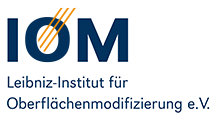The water background pressure in the process chamber, a factor that has received little attention to date in the ultra-precise machining of optical surfaces, has been investigated by researchers from the “Ion Beam Assisted Patterning and Smoothing” working group and the “Material Characterization and Analytical Service” cross-section at the IOM. This study provides important insights into the ultra-precision manufacturing of optical components.
Reactive ion beam etching (RIBE) is a key technology for the ultra-precise structuring of optical materials such as silicon dioxide (SiO₂) and silicon (Si). The results of the study show that even small amounts of residual water in the background pressure of the process chamber significantly influence the composition of the ion beam, as well as the surface layer modified by the ion beam, with direct effects on the etching process and material selectivity.
The interaction between the reactive ion beam and the surfaces was investigated using energy-selective mass spectrometry (ESMS), secondary ion mass spectrometry (ToF-SIMS), and X-ray photoelectron spectroscopy (XPS). The measurement results show the formation of a stable oxygen-containing hydrocarbon layer and a Si(OF) layer, the thickness and composition of which depend on the water background pressure. This has a direct influence on the etching efficiency and represents a challenge for process stability in industrial applications.
These findings are particularly relevant for the manufacture of large-area optical elements, where a substrate change is usually accompanied by ventilation of the process chamber - and thus the entry of atmospheric water into the chamber. The study emphasizes that precise control of the water background pressure is crucial to ensure reproducible etching rates and accurate pattern transfer.
The research results also contribute to optimizing existing etching processes and developing new strategies for increasing reproducibility, thus making an important contribution to the further development of ultra-precision optics.
The results of the study were recently published in the following publication:
Peter Birtel, Erik Rohkamm, Jens Bauer, Frost Frank
Influence of water background pressure on removal rates of SiO2, Si and photo resist in reactive ion beam etching
Surfaces and Interfaces, Vol. 64, p. 106306 (2025)
https://doi.org/10.1016/j.surfin.2025.106306

